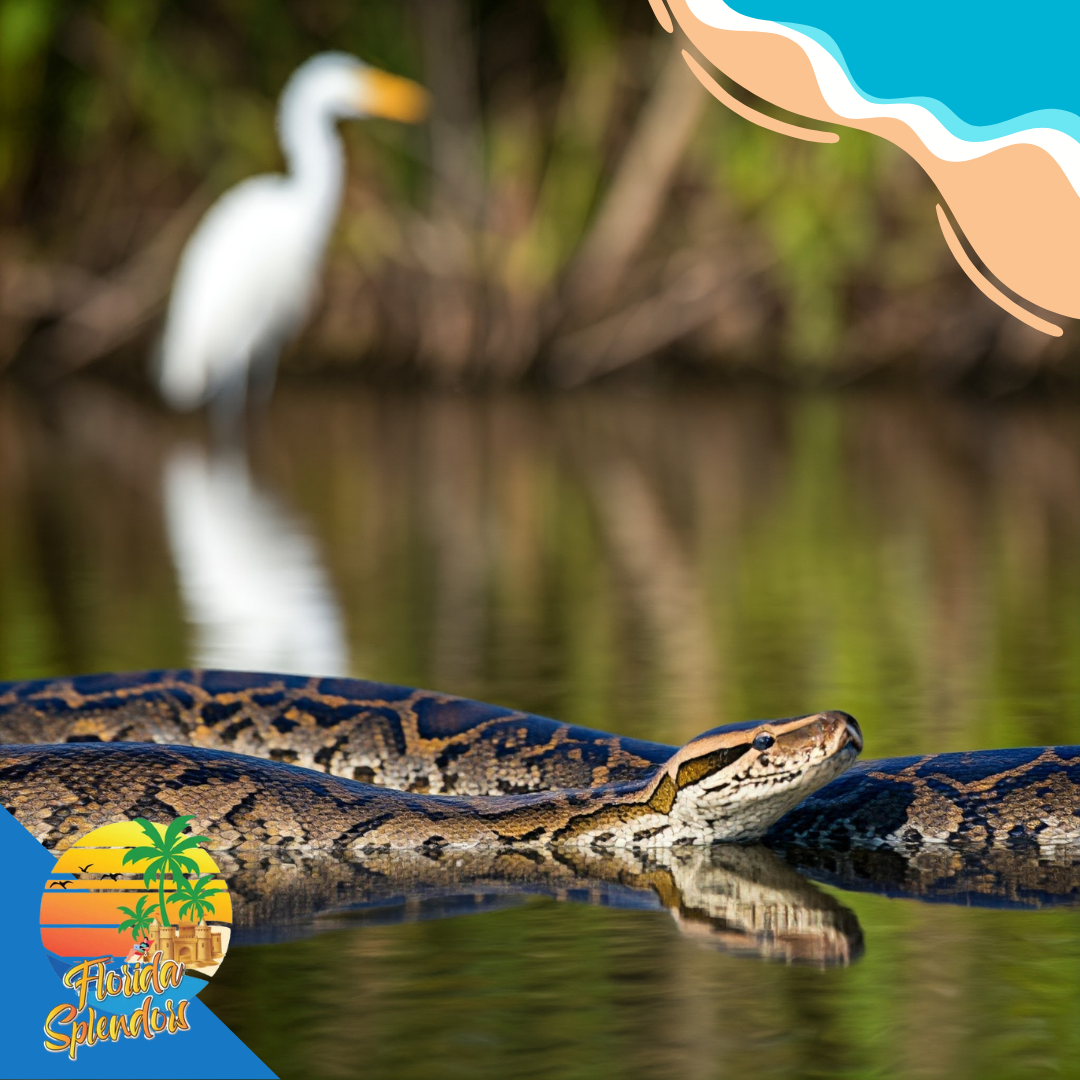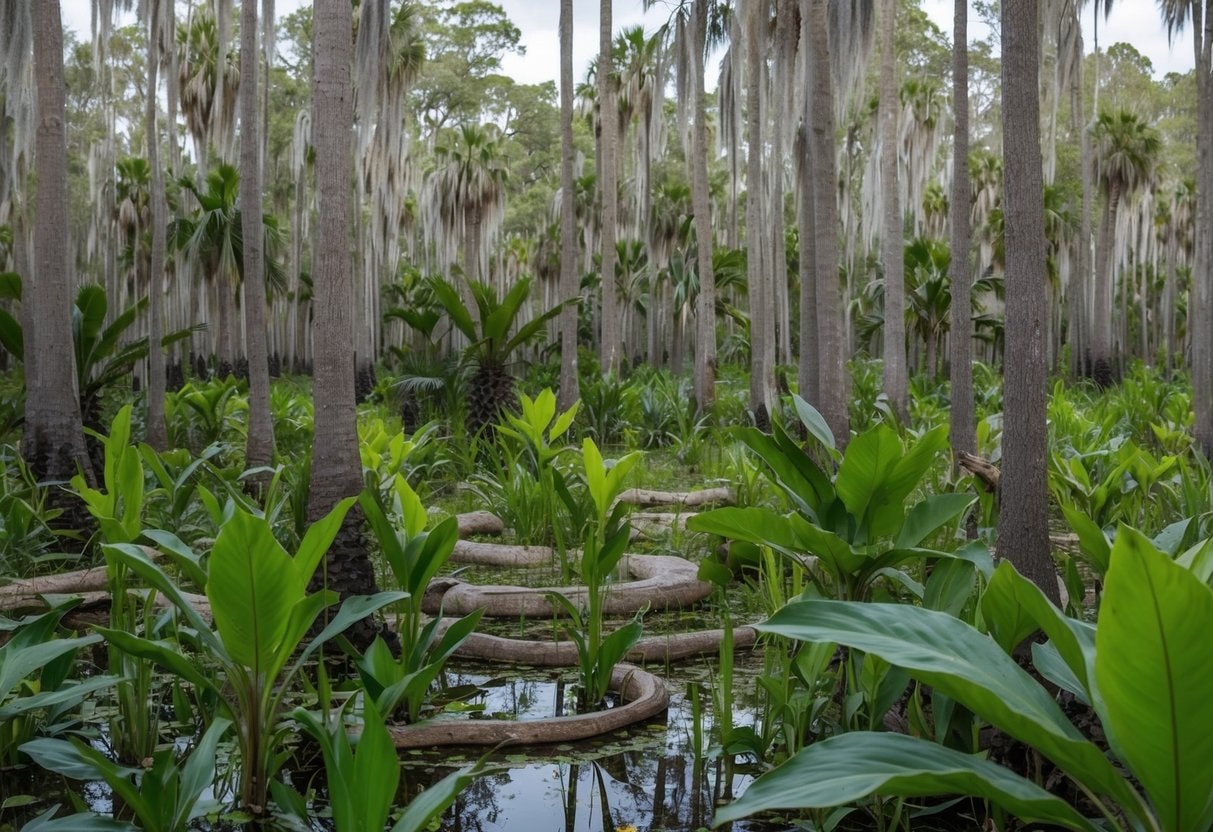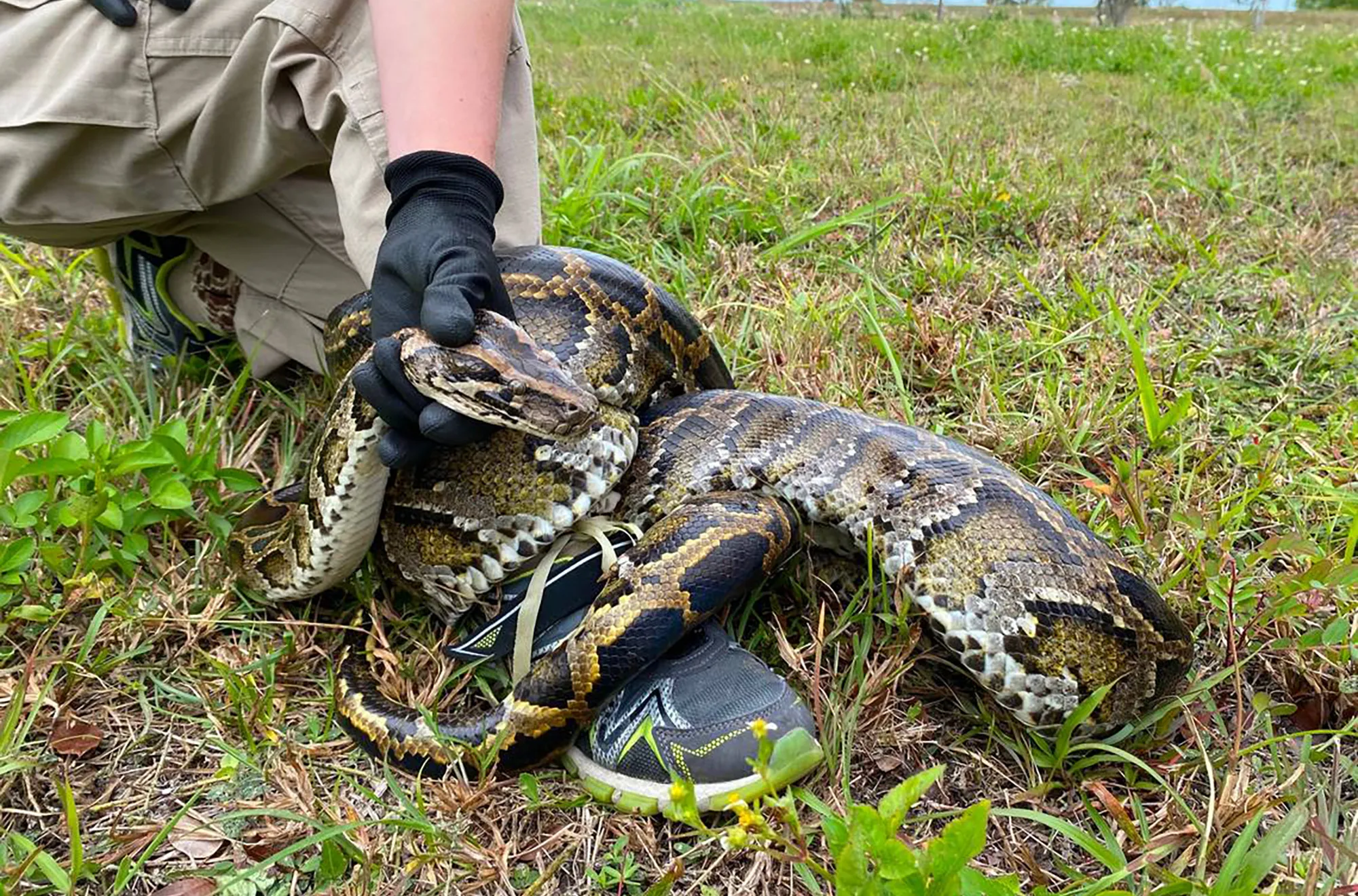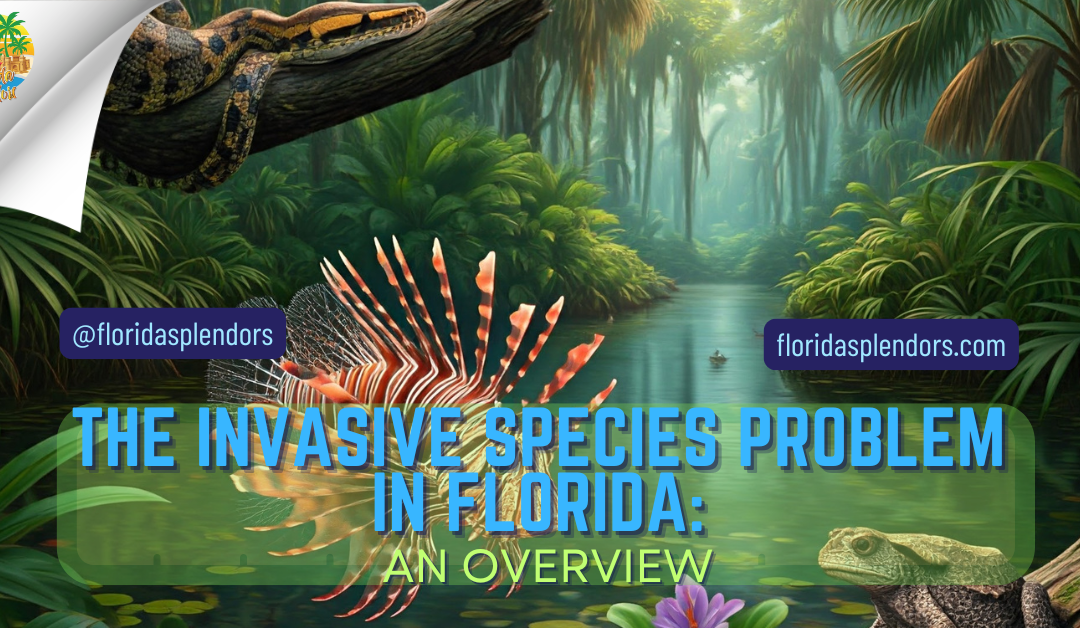==================
Florida Splendors is supported by our audience. When you purchase through one of our links, we may earn a small affiliate commission. As an Amazon Associate I earn from qualifying purchases. Your cost is not affected.
Florida’s rich and diverse ecosystems are facing a growing crisis, with the Invasive Species Problem in florida affecting the state’s environment, economy, and residents. Invasive plant and animal species are rapidly altering the natural balance. From the sprawling Everglades to suburban backyards, these non-native invaders are reshaping habitats, pushing out native species, and threatening the delicate biodiversity that makes Florida unique.
The toll on agriculture, wildlife, and even tourism is staggering, with billions of dollars spent on damage control and restoration efforts. To understand the severity of this issue, it’s essential to explore the causes, consequences, and potential solutions for Florida’s invasive species problem. Let’s dive into what’s driving this ecological threat and what can be done to stop it.
The Invasive Species Problem in Florida: An Overview – Friendly Guide to Understanding the Issue

Florida faces a growing problem with non-native plants and animals taking over its ecosystems. These invasive species cause harm to the environment and cost millions to control each year. Florida spends about $100 million annually just to manage invasive plants. From pythons in the Everglades to lionfish in coastal waters, Florida’s unique habitats are under threat. Invasive species can outcompete native plants and animals for resources. They often lack natural predators, allowing their populations to grow unchecked.
Scientists are working hard to find solutions. They study which new species might arrive next and how to stop them. Education programs teach people the risks of releasing non-native pets or plants into the wild. With continued efforts, Florida hopes to protect its one-of-a-kind ecosystems for future generations.
Key Takeaways
- Invasive species harm Florida’s environment and economy.
- Florida’s diverse habitats face threats from many non-native plants and animals.
- Researchers and educators work to prevent and control invasive species.

Understanding Invasive Species
The Invasive Species Problem in Florida causes significant harm to local plants and animals. These invaders, many of which come from other regions, spread rapidly and disrupt ecosystems.

Defining Invasive Species
Invasive species are plants or animals that don’t belong in an area. They come from other places and cause harm. These species grow and spread quickly. They hurt local plants and animals.
Invasive species can be any type of living thing. Plants, animals, and even tiny organisms can be invasive. They push out native species and change the environment.
Not all non-native species are invasive. Some fit in without causing harm. However, invasive ones make significant changes and cost a lot to control.
Pathways to Invasion
Invasive species get to new places in many ways. Some are brought on purpose for pets or gardens. Others come by accident. Here are common ways invasive species spread:
- Pet trade and release.
- Hitchhiking on boats or cars.
- Escaping from farms or gardens.
- Coming in soil or packaging.
- Riding ocean currents.
People play a significant role in moving invasive species. Many invasive plants and animals arrive through human actions. Climate change also helps some species invade new areas.
Notable Invasive Species in Florida
Florida has many invasive species. They live on land and in water. Here are some well-known ones:
- Burmese Pythons: These giant snakes eat local animals in the Everglades.
- Brazilian Pepper Trees: They crowd out native plants and spread fast.
- Lionfish: These fish harm coral reefs and eat many small fish.
Melaleuca trees and cogongrass are also significant problems. They take over large areas quickly. New invasive species are always a threat. Scientists watch for potential invasive species that might come to Florida. Early action helps stop their spread.
History and Impact

The Invasive Species Problem in Florida has grown significantly over the years. These non-native plants and animals have disrupted the state’s ecosystems and caused severe economic issues. Let’s look at how The Invasive Species Problem in Florida started and what it means for the state today.
Historical Overview
The first documented invasive species in Florida was the Greenhouse Frog in 1863. It came from the West Indies. Since then, many more plants and animals have arrived in the state. Some were brought on purpose for gardens or as pets. Others came by accident on ships or in cargo.
As Florida’s population grew, so did the number of invasive species. By the late 20th century, Florida had become home to hundreds of non-native species. The warm climate made it easy for them to survive and spread.
The Ecological Impacts of Invasive Species
Invasive species have changed Florida’s natural areas in significant ways. They often push out native plants and animals. This hurts the balance of local ecosystems. The Burmese Python is a famous example. These giant snakes eat many native animals in the Everglades.
They’ve caused significant drops in mammal populations there. Invasive plants can also cause problems. They might grow faster than native plants and take over. This can change how fires spread and how water moves through the land.
Economic and Social Consequences
The invasive species problem costs Florida a lot of money. The state spends about $100 million each year just to manage invasive plants. The cost of dealing with invasive animals could be even higher. These costs affect many parts of Florida’s economy:
- Farming: Invasive pests can damage crops.
- Tourism: Some invasive species can make outdoor areas less appealing.
- Property Values: Invasive plants can lower home prices.
People’s daily lives are affected too. Some invasive species can be dangerous to humans or pets. Others might damage buildings or roads.
The Invasive Species Problem in Florida: Regional Challenges

Florida faces unique issues with invasive species in different areas. The Everglades and Florida Keys are two spots with big problems. Let’s look at what’s happening in these places.
The Everglades Ecosystem
The Everglades is a special wetland in Florida. It’s having a tough time with invasive plants and animals. Invasive species are hurting native plants and animals here. They change how water moves, making it hard for local species to live. Some big problems are:
- Burmese pythons eat native animals.
- Melaleuca trees are taking over wetlands.
- Brazilian pepper crowding out other plants.
People are trying to fix these issues. They remove invasive plants and catch pythons. But it’s a big job that takes a lot of work and money.
The Unique Case of the Florida Keys
The Florida Keys are islands with many rare plants and animals. These islands face special challenges with invasive species. The warm weather and many visitors make it easy for new species to arrive. Some problems in the Keys are:
- Lionfish hurting fish populations.
- Iguanas eat native plants.
- Australian pine trees changing beaches.
The Keys’ small size makes these problems worse. Invasive species can spread fast and cause a lot of damage. People in the Keys work hard to protect their special ecosystem. They teach visitors about not bringing in new plants or animals. They also have programs to remove invasive species.

Did you Know?
The Sunshine State runs many programs to teach people about invasive species. These efforts help folks spot and report harmful plants and critters. Florida’s youth learn about invasive species through special projects. Kids get hands-on experience with plant biosecurity.
Legislation and Management

The Invasive Species Problem in Florida is taken very seriously. Laws and programs aim to stop new invaders and control existing ones. People, groups, and officials work together to address The Invasive Species Problem in Florida and protect the state’s native plants and animals.
Federal and State Regulations
The U.S. government and Florida have rules to fight invasive species. The Lacey Act bans bringing in harmful plants and animals. Florida has its laws, too. The Florida Fish and Wildlife Conservation Commission makes rules about invasive wildlife. They decide which animals can’t be owned as pets. There are also laws about moving certain plants between states. This helps stop the spread of invasive plants.
Invasive Species Management Initiatives
Florida has many programs to deal with invasives. The Python Patrol trains people to catch Burmese pythons. These huge snakes hurt the Everglades ecosystem. Cooperative Invasive Species Management Areas bring different groups together. They work on local invasive problems. The state spends about $100 million yearly to manage invasive plants. This shows how big the problem is.
Community-Based Efforts
Regular people help fight invasives, too. Volunteer groups remove invasive plants from parks and beaches. Some folks learn to spot and report new invaders. Schools teach kids about native and non-native species. This helps the next generation understand the issue. Many cities have “Weed Warrior” programs. These train people to remove invasive plants safely. It’s a hands-on way for anyone to help protect Florida’s environment.
Science and Research
Scientists in Florida are working hard to stop The Invasive Species Problem in Florida. They study how these plants and animals spread and cause harm. Researchers also look for new ways to keep them out and control those already here, all to combat The Invasive Species Problem in Florida.
Research at the University of Florida
The University of Florida leads efforts to fight invasive species. Their Invasion Science Research Institute brings experts together. They study how invaders affect the environment and economy. UF researchers use new tech to track invasives.
This includes drones and DNA testing. They also create maps to show where problem species might spread. The university works with farmers, too. They teach ways to protect crops from invasive pests. UF’s IFAS Extension shares this info with the public.
Advancements in Biosecurity
Florida is getting better at keeping out unwanted species. Scientists are improving border checks for plants and animals. They use special tools to find tiny pests in shipments. Researchers also study which species might invade next. A recent study looked at 460 possible invaders.
It found 40 that could cause big problems. This helps Florida prepare. New tech helps, too. Underwater robots look for invasive fish. Smart traps catch and ID pests automatically. These tools make it easier to protect Florida’s nature.
Prevention and Control

The Invasive Species Problem in Florida presents big challenges for the state. Stopping them takes teamwork and quick action. There are ways to spot new invaders early and deal with the ones already here.
Identification and Early Detection
Spotting invasive species fast is critical. Florida has special groups that look for new invaders. They check spots where pests might show up first. People can help, too. Learning what invasive plants and animals look like is important. If you see something odd, tell the experts right away. New tech helps a lot. Special apps let folks send photos of weird plants or bugs. This helps track where invasives pop up.
Controlling Established Populations
Once invaders take hold, it’s harder to get rid of them. But there are still ways to fight back. Some methods include:
- Pulling out plants by hand.
- Using safe chemicals.
- Bringing in natural enemies of the pest.
For animals, traps can work. Sometimes, experts have to catch and remove them. It costs a lot. Florida spends about $100 million each year just on invasive plants.
The Role of Community in Prevention
Everyone in Florida can help stop invasives. It’s not just up to the experts. Don’t let pets go free. Many invasives started as escaped pets. Florida has pet amnesty days where you can give up exotic pets safely. Be careful what you plant. Some pretty garden plants can spread and cause trouble.
Clean your boat and gear after trips. This stops water weeds and tiny animals from spreading. Tell others about the problem. The more people who know, the better we can protect Florida’s special places.
Looking Ahead

The Invasive Species Problem in Florida is prompting significant changes in the state’s efforts to protect its ecosystems. As Florida confronts this pressing issue, new challenges and innovative solutions are emerging to safeguard its native plants and animals.
Challenges in the Face of Climate Change
Climate change is making it harder to deal with invasive species in Florida. Some invasive plants and animals can spread to new areas as the weather gets warmer. This puts more pressure on native species that are already struggling.
Rising sea levels are also changing coastal habitats. This can help some invasive species take over new spots. At the same time, it makes it more challenging for native plants and animals to survive. Extreme weather events like hurricanes can spread invasive species, too. Strong winds and floods can carry seeds or small creatures to new places.
Innovations in Invasive Species Management
Florida is trying new ways to fight invasive species. Scientists are using high-tech tools to find and track these unwanted guests. Drones and satellite images help spot invasive plants from above. This makes it easier to plan removal efforts.
Researchers are also looking at new biological controls. These are natural predators or diseases that can keep invasive species in check without hurting native wildlife. Some teams are testing special traps and baits. These can catch invasive animals without harming other creatures.
Protecting Florida’s Environment for the Future
Florida is working hard to save its unique ecosystems. The state is making plans to guard against future invasions. Education is a big part of this effort. Teaching people about invasive species helps stop their spread. Kids in schools are learning how to spot and report invasive plants and animals.
Conservation groups are working to restore native habitats. This gives local plants and animals a better chance to thrive. Florida is also tightening rules on bringing in non-native species. This helps stop new invasions before they start.
Here’s an additional video about the invasive species problem in Florida.
By: Tsuki
The Path Ahead: Protecting Florida’s Ecosystems from Invasive Threats
In conclusion, the invasive species problem in Florida is a complex and multifaceted crisis that poses significant threats to the state’s unique ecosystems, economy, and the well-being of its residents. With the ongoing encroachment of non-native plants and animals, the delicate balance of Florida’s rich biodiversity is at stake. From the historical introduction of invasive species to their contemporary impacts on agriculture and tourism, it is clear that urgent action is required. Collaborative efforts among scientists, policymakers, and the community are vital for effective management and prevention strategies.
Florida can better protect its natural heritage by raising awareness, promoting responsible pet ownership, and supporting initiatives for habitat restoration. As the state navigates the challenges posed by climate change and the ever-present threat of new invaders, proactive measures must be taken to safeguard Florida’s diverse environments for future generations. Through innovation, education, and community engagement, there is hope for mitigating the impact of invasive species and preserving the state’s ecological integrity.
Frequently Asked Questions
What's Inside
- What Are the Top Invasive Species Currently Affecting Florida's Ecosystems?
- How Do Invasive Species Impact Florida's Native Wildlife and Plant Communities?
- Can You List Some Ways That Invasive Species Have Been Introduced to Florida?
- What Measures Are Being Taken to Manage Invasive Species in the Florida Everglades?
- Which Invasive Species in Florida Have a Bounty Program for Their Management or Removal?
What Are the Top Invasive Species Currently Affecting Florida's Ecosystems?
Burmese pythons have significantly impacted South Florida. They eat native wildlife and have caused significant declines in mammal populations. Giant African land snails are a serious pest. They damage crops and buildings and can spread disease. Hydrilla is an invasive water plant. It covered over 45,000 acres of Florida’s public waters in 2007.
How Do Invasive Species Impact Florida's Native Wildlife and Plant Communities?
Invasive species compete with native plants and animals for food and habitat. This can lead to declines in native populations. Some invaders, like pythons, directly prey on native wildlife. Others may change the environment to make it less suitable for native species. The Nature Conservancy estimates invasive plants alone cost $100 million annually to manage in Florida.
Can You List Some Ways That Invasive Species Have Been Introduced to Florida?
Pet releases are a common source. Burmese pythons likely entered the wild this way. Some plants were brought in for landscaping or agriculture and then spread. Hydrilla was first sold as an aquarium plant. Cargo ships can accidentally transport species in ballast water or attached to their hulls.
What Measures Are Being Taken to Manage Invasive Species in the Florida Everglades?
Python removal programs use trained hunters to catch and remove snakes. Some snakes are fitted with tracking devices to find others. Controlled burns help manage some invasive plants. Herbicides are used in some cases. Public education is key. People are taught how to identify and report invasive species.
Which Invasive Species in Florida Have a Bounty Program for Their Management or Removal?
The Python Elimination Program pays hunters to remove Burmese pythons. Hunters get a base pay plus bonuses for larger snakes. Lionfish also have a bounty program. Divers can earn money by removing these invasive fish. Some counties offer bounties for feral hogs, which damage crops and natural areas.
Ready to Discover Florida’s Hidden Treasures?
Join the Florida Splendors community for a world of inspiration and adventure! Uncover secret spots, connect with fellow adventurers, and celebrate your passion for the Sunshine State. Whether you’re into kayaking through tranquil waters, relaxing on pristine beaches, or exploring vibrant cities, we’ve got it all covered!
Follow us on:
Let’s embark on Florida’s greatest adventures together!

